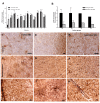Cellular injury and neuroinflammation in children with chronic intractable epilepsy
- PMID: 20021679
- PMCID: PMC2811703
- DOI: 10.1186/1742-2094-6-38
Cellular injury and neuroinflammation in children with chronic intractable epilepsy
Abstract
Objective: To elucidate the presence and potential involvement of brain inflammation and cell death in neurological morbidity and intractable seizures in childhood epilepsy, we quantified cell death, astrocyte proliferation, microglial activation and cytokine release in brain tissue from patients who underwent epilepsy surgery.
Methods: Cortical tissue was collected from thirteen patients with intractable epilepsy due to focal cortical dysplasia (6), encephalomalacia (5), Rasmussen's encephalitis (1) or mesial temporal lobe epilepsy (1). Sections were processed for immunohistochemistry using markers for neuron, astrocyte, microglia or cellular injury. Cytokine assay was performed on frozen cortices. Controls were autopsy brains from eight patients without history of neurological diseases.
Results: Marked activation of microglia and astrocytes and diffuse cell death were observed in epileptogenic tissue. Numerous fibrillary astrocytes and their processes covered the entire cortex and converged on to blood vessels, neurons and microglia. An overwhelming number of neurons and astrocytes showed DNA fragmentation and its magnitude significantly correlated with seizure frequency. Majority of our patients with abundant cell death in the cortex have mental retardation. IL-1beta, IL-8, IL-12p70 and MIP-1beta were significantly increased in the epileptogenic cortex; IL-6 and MCP-1 were significantly higher in patients with family history of epilepsy.
Conclusions: Our results suggest that active neuroinflammation and marked cellular injury occur in pediatric epilepsy and may play a common pathogenic role or consequences in childhood epilepsy of diverse etiologies. Our findings support the concept that immunomodulation targeting activated microglia and astrocytes may be a novel therapeutic strategy to reduce neurological morbidity and prevent intractable epilepsy.
Figures





Similar articles
-
Increased activation of Iba1+ microglia in pediatric epilepsy patients with Rasmussen's encephalitis compared with cortical dysplasia and tuberous sclerosis complex.Neurobiol Dis. 2009 Jun;34(3):432-40. doi: 10.1016/j.nbd.2009.02.015. Epub 2009 Mar 10. Neurobiol Dis. 2009. PMID: 19285133 Free PMC article.
-
Unilateral holohemispheric central nervous system lesions associated with medically refractory epilepsy in the pediatric population: a retrospective series of hemimegalencephaly and Rasmussen's encephalitis.J Neurosurg Pediatr. 2014 Dec;14(6):573-84. doi: 10.3171/2014.8.PEDS13613. Epub 2014 Oct 10. J Neurosurg Pediatr. 2014. PMID: 25303156
-
The IL-1beta system in epilepsy-associated malformations of cortical development.Neurobiol Dis. 2006 Oct;24(1):128-43. doi: 10.1016/j.nbd.2006.06.003. Epub 2006 Jul 24. Neurobiol Dis. 2006. PMID: 16860990
-
Surgery for intractable seizures in infancy and early childhood.Neurology. 1993 Nov;43(11 Suppl 5):S28-37. Neurology. 1993. PMID: 8232985 Review.
-
Relationship between the chemokine receptor CCR5 and microglia in neurological disorders: consequences of targeting CCR5 on neuroinflammation, neuronal death and regeneration in a model of epilepsy.CNS Neurol Disord Drug Targets. 2013 Sep;12(6):815-29. doi: 10.2174/18715273113126660173. CNS Neurol Disord Drug Targets. 2013. PMID: 24047524 Review.
Cited by
-
Opposing actions of hippocampus TNFα receptors on limbic seizure susceptibility.Exp Neurol. 2013 Sep;247:429-37. doi: 10.1016/j.expneurol.2013.01.011. Epub 2013 Jan 16. Exp Neurol. 2013. PMID: 23333565 Free PMC article.
-
Reactive oxygen species-responsive drug delivery systems for the treatment of neurodegenerative diseases.Biomaterials. 2019 Oct;217:119292. doi: 10.1016/j.biomaterials.2019.119292. Epub 2019 Jun 21. Biomaterials. 2019. PMID: 31279098 Free PMC article. Review.
-
Antecedents of epilepsy and seizures among children born at extremely low gestational age.J Perinatol. 2019 Jun;39(6):774-783. doi: 10.1038/s41372-019-0355-4. Epub 2019 Mar 27. J Perinatol. 2019. PMID: 30918341 Free PMC article.
-
Candidate drug targets for prevention or modification of epilepsy.Annu Rev Pharmacol Toxicol. 2015;55:229-47. doi: 10.1146/annurev-pharmtox-010814-124607. Epub 2014 Aug 25. Annu Rev Pharmacol Toxicol. 2015. PMID: 25196047 Free PMC article. Review.
-
Predicting novel histopathological microlesions in human epileptic brain through transcriptional clustering.Brain. 2015 Feb;138(Pt 2):356-70. doi: 10.1093/brain/awu350. Epub 2014 Dec 16. Brain. 2015. PMID: 25516101 Free PMC article.
References
Publication types
MeSH terms
Substances
Grants and funding
LinkOut - more resources
Full Text Sources
Other Literature Sources
Medical
Miscellaneous

